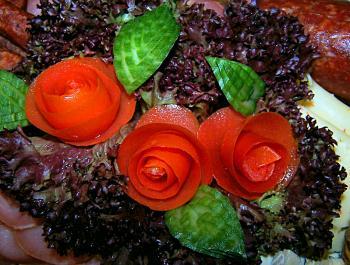Goya, the family name of the beloved painter of Spain, is familiar to all who have visited the Prado Gallery in Madrid. The famous name is also shared by an unassuming vegetable, with unusually valuable properties. It makes the hearts of physicians, dieticians and alternative healers beat faster, but the general public knows very little about the healthful properties of this medicinal plant, which is also a culinary star.
Those privileged few interested in good health know that goya, also known as bitter melon, enhances well-being and keeps urine and blood quality healthy. The plant is even reputed to normalize body weight. Type II diabetics in particular should be encouraged by bitter melon’s blood sugar-stabilizing properties, and its ability to regulate metabolism. And goya has even more advantages: it acts as an antioxidant, a blood cleanser and it regulates the body’s fatty acid systems. Even the gall bladder and the liver benefit from it, as does the digestive tract. The melon contains iron, calcium, phosphorus, potassium and vitamins A, B1, B2 and C. Consuming a serving of this melon per day can refresh and revitalize the whole body, while removing toxins from the system.
Goya goes by a few names—bitter melon, bitter spring cucumber or bitter squash. It belongs to the family curcubitacae. There are a number of varieties grown in countries within Asia and Africa, as well as Peru. (They are used mainly in folk medicine applications, primarily in diabetes-related matters.) Europeans and people in the United States are now raising this vegetable, too. The variety momordica charantia cannot be consumed raw, as it is extremely bitter. German palates can’t quite tolerate this deeply grooved variety, due to the degree of bitterness, so they would be better off purchasing a smoother variety.
Goya that is well-cooked is only mildly bitter, making it an excellent compliment to pork dishes. A delightfully flavorful Vietnamese dish consists of a hollowed-out goya stuffed with seasoned forcemeat (chopped meat). It is then braised or steamed in its entirety. To get a sense of the degree of bitterness of one of these plants, the cooked goya to the raw goya can be likened in degree of difference to a mild green pepper vs. an extremely hot habanero pepper. Those who have bitten into a red hot pepper by mistake will understand what I am talking about.
The best way to take advantage of the plant’s many beneficial properties is to consume it in the form of a tea made from the dried parts of the plant. Tea bags are available in most Asian markets, or one can prepare one’s own infusion at home, steeping the dried parts for three minutes in boiling water.
There are other means available for consuming this plant - via capsules and tablets which any healthfood store or pharmacy can order. The price differs greatly, though, which is why tea is suggested. For those who only occasionally wish to consume goya, they should head for an Asian market, buy a fresh one and cook it. Not every place is fortunate enough to have ready access to the freshly grown bitter melon—Germany does not. Along with Asian markets, healthfood stores may sell the vegetable, or perhaps a specialty plant nursery would sell the seeds or plants for gardening purposes.
British Researchers Discover ‘Plant Insulin’
Fundamental damage from diabetes usually does not arise directly from the illness itself, but from constantly vacillating insulin levels. The pancreas creates the hormone insulin, which the body requires to get the cells ready for glucose uptake. This process translates into energy production and consumption. The liver is the “watchman,” assuring that the sugar level will remain in proper equilibrium, even up to two hours after food is consumed. When this process is interrupted or disturbed, the body becomes out of balance, requiring external intervention.
When the body contains a dangerously high level of glucose, the body systems will become compromised. Serious consequences can include hyperglycemia, damaged blood vessels, eye damage, heart and joint injuries and damage to other internal organs. Bitter melon contains a substance British researchers have dubbed “plant insulin.” That is why diabetics, on a daily basis, can benefit greatly from derivatives of this plant.
If you have a delicate stomach, a stomach ulcer or are prone to heartburn, and are planning to consume goya in any shape or form for longer than two weeks, you need to consult your health care professional. The same advice goes for those who have been taking high doses of this plant and wish to lower the dosage. Pregnant and lactating women must not experiment with goya, as no research relating to children exists. Likewise, those who are allergic to cucumbers, melons or squashes should not consume this plant in any form.
So the next time you hear the name Goya, you may still think first of the master of the paint palette, with his transcendent paintings to inspire the spirit, but don’t forget about the other goya, bitter melon, the master of the taste palate, which possesses benefits for health and well-being.


